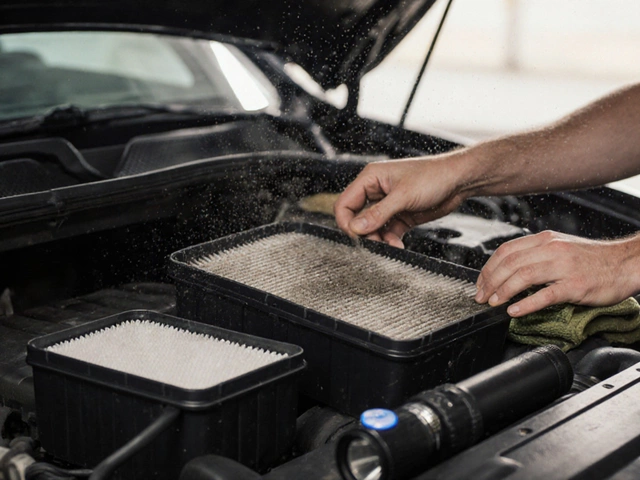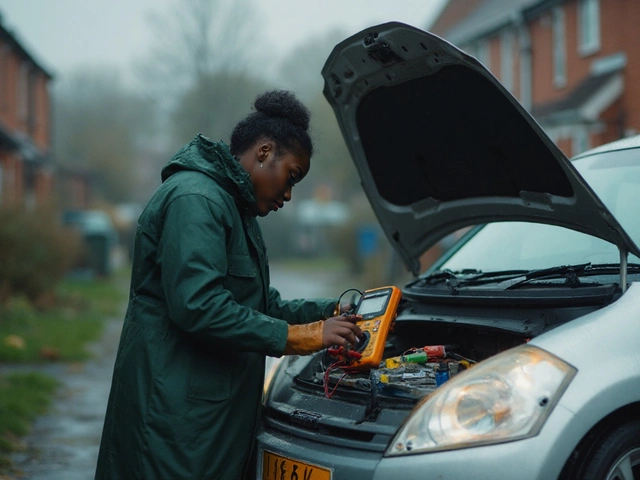Ever hear that strange noise coming from your car and wonder what it could be? If it's a clunk, rattle, or squeak when you hit a bump or make a turn, there's a good chance your struts might be screaming for attention. Not everyone knows this, but bad struts can transform your smooth ride into a symphony of concerning sounds.
First, let's talk about what these sounds might mean. A 'clunking' or 'banging' noise often grows louder over time, indicating that your strut mount might be loose or worn out. If it's more of a 'squeaking' or 'creaking,' you might be dealing with a strut bushing issue. Either way, these noises aren't just annoying—they're a sign your struts aren't doing their job as shock absorbers.
- Recognizing the Noise
- Why Struts Fail
- Preventative Maintenance
- DIY or Professional Repair
- When It's Time to Replace
Recognizing the Noise
Identifying the sounds of a bad strut isn't always straightforward, but knowing what to listen for can save you from future headaches and expenses. Struts, being a key player in your vehicle's suspension system, will vocalize their distress if something's off.
Clunking Sounds
A common indicator of worn-out struts is a clunking noise. If you're hearing this, especially when going over bumps, it could mean that the internal components of the strut are damaged or loose. This might happen because the strut mount is not securing the strut properly, allowing unwanted movement.
Squeaking or Creaking
If your ride's struts seem to chatter more than your morning alarm, it could be due to failing bushings or dry joints within the suspension. This sound is generally more noticeable during colder temperatures or when moisture finds its way into the joints.
Rattling
This noise often sounds like metal tapping against metal, which could indicate that the strut is not fitted tightly. Rattling is particularly evident when the car is moving slow and only over uneven surfaces.
Importance of Paying Attention
Ignoring these noises can lead to more severe suspension issues. Over time, this may affect your car's alignment and even tire wear, causing the vehicle to pull to one side when driving straight. Many car owners report suspension failure as one of the top unexpected repair costs.
Remember, even though not every noise means you need an immediate strut replacement, car maintenance is essential. Regularly scheduled check-ups can catch these issues early, saving you from costly repairs later. So, keep your ears peeled and don't let those unknown car sounds go unnoticed!
Why Struts Fail
Let's get into the nitty-gritty of why your car's struts might start failing and making those unsettling noises. Struts are not just for comfort; they play a crucial role in your vehicle's safety and handling. When they start to go bad, it can affect both how your car feels and how it performs on the road.
Common Reasons for Strut Failure
The main reasons why struts might fail include normal wear and tear, exposure to harsh road conditions, and sometimes a bit of neglect. These things add up over time, and before you know it, you're dealing with a noisy problem.
- Wear and Tear: Struts are constantly under stress every time you drive. Over time, the seals and bushings can wear out, leading to leaks and reduced efficiency.
- Road Conditions: If you often drive on rough or pothole-filled roads, you're demanding more from your struts. The constant impact can accelerate their wear.
- Lack of Maintenance: Ignoring regular check-ups can cause small issues to become big problems. Sometimes, all it takes is a bit of grease or a timely replacement to avoid a bigger headache.
Recognizable Signs
Like any car part, struts give off warning signs when they start to fail. Understanding these signals can help you address issues before they get worse:
- Leaking Hydraulic Fluid: If you see fluid on the outside of your strut, the seal might be compromised.
- Car Sitting Low: A sagging car might indicate weak struts.
- Uneven Tire Wear: This often results from poor suspension alignment caused by failing struts.
"Struts are vital in maintaining a vehicle’s control and posture. Ignoring early signs of failure can lead to compromised safety," advises John Hartman, a veteran automotive engineer.
Is It Time for Replacement?
Understandably, no one wants to spend money on car repairs unless necessary. But delaying is never wise. As a rule of thumb, consider replacing struts every 50,000 to 100,000 miles, depending on your driving conditions and habits.
If your car's showing symptoms of bad struts, it might be time to check things out. Regular inspections can literally save your life on the road, not to mention a few bucks in your wallet.

Preventative Maintenance
When it comes to keeping your car's suspension system in top shape, a little TLC for those struts can go a long way. Let's face it, no one wants to deal with the hassle or cost of sudden repairs, especially when you can avoid them with some simple steps.
The Basics
You want to start by regularly checking your car suspension. A quick glance under the vehicle can help you spot any leaks, which are a major red flag for worn-out struts. Don't ignore those damp patches, especially around the strut assembly, because they're a quiet but sure sign something's off.
Listen and Feel
Keep an ear out for unusual noises while driving. Don't brush off those sudden squeaks or clunks. As soon as you hear something strange, get it checked. Maintaining an awareness of how your car feels—like if the ride isn't as smooth as before—can help you catch issues early.
Regular Inspections
Get a professional inspection done every 20,000 to 30,000 miles. It might sound like a chore, but a certified mechanic can detect problems that aren't easily noticeable. According to Jake Thompson, a renowned auto expert,
“Regular maintenance is key. Don't wait for your car to scream for help.”This proactive approach can save you big bucks down the road.
DIY Tips
- Check tire pressure regularly. Struts and tires work hand-in-hand, so it's vital both are aligned.
- Rotate your tires every 5,000 miles to ensure even wear and tear.
- Consider lubricating the strut mount from time to time.
Cost vs. Prevention
You might be skeptical about spending on regular checks, but the cost of not doing so can be much greater in the long run. A new strut replacement can set you back anywhere from $150 to $450 for just one, not including labor costs. Compare that to a standard inspection fee or minor interventions, and it starts to make financial sense.
| Service Type | Estimated Cost |
|---|---|
| Standard Inspection | $50 - $100 |
| Strut Replacement | $150 - $450 per strut |
DIY or Professional Repair
When you're trying to decide between tackling a strut replacement yourself or hiring a pro, there's a lot to think about. It’s not just about saving money—although that's a big part of it—but also about your confidence in handling car repairs and your safety. So, what should you do?
Consider Your Skill Level
If you've already navigated a few car repair projects successfully, you might feel ready to swap out those dodgy struts. DIYing can be a real money-saver! On average, replacing a strut at home can cut the cost by half compared to a shop.
Bad strut work isn't like changing your oil or replacing your wiper blades, though. It involves car jacks, special tools, and sometimes compressing the springs safely. Messing this up could lead to serious injuries or more harm to your car.
Tools You’ll Need
If you're in for the DIY route, here’s what you might need:
- Torque wrench
- Spring compressor
- Sockets and ratchets
- Jack stands and hydraulic jack
"Remember, not all tools are created equal, and the right gear ensures you get the job done safely." - AutoZone Mechanics Team
Weighing Professional Repair
Now, let's look at the flip side. Taking your car to a professional for car maintenance could mean a heavier bill, but it's also less stress. Most mechanics have years of experience, ensuring the job is done right the first time.
When deciding, weigh the pros and cons. Consider if the time saved and peace of mind are worth the extra bucks. Plus, good shops give you warranty perks most home projects can't offer.
According to a survey by AAA, about 66% of drivers prefer going to a repair shop for complex suspension issues due to lack of time or expertise.
The Bottom Line
Ultimately, whether you pick DIY or a professional service depends on your comfort level and how much you're willing to spend versus effort and potential risk. If you're unfamiliar with suspension parts like a car suspension, play it safe. Otherwise, if you enjoy hands-on work and have the right tools, doing it yourself could be a fruitful challenge.

When It's Time to Replace
Recognizing when your car’s bad strut needs replacing isn't just about listening for odd noises. You can keep an eye out for some telltale signs that scream replacement time.
Signs of Suspension Trouble
One major indicator is your car leaning heavily to one side or that unmistakable bouncing as you drive over bumps. Does your car nosedive when you hit the brakes? It could mean your strut noise has gone past the point of simple fixes.
- Nose-diving or rear-end squat: These occur during hard stops or acceleration, signaling that your struts are no longer providing the resistance they should.
- Tire wear: Uneven or rapid tire wear can result from suspension issues. Noisy struts might be part of the problem.
- Fluid leaks: Struts use fluid to dampen motion. If you spot oil or fluid near the strut, it's time to consider replacing it.
Check the Mileage
Most struts are designed to last between 50,000 to 100,000 miles. If you’re hitting those numbers, it's probably wise to get them inspected, even if everything seems fine.
The Cost-Benefit Analysis
Replacements might sound pricey, but the cost of ignoring them can be far worse. Leaving car suspension problems unaddressed can lead to more significant damage—and more expensive repairs—down the road.
Replace or Repair?
If you're more of a DIY kind of person, you might think about swapping out the struts yourself. However, modern vehicles can have pretty complex systems, and a professional might be your best bet to keep from doing more harm than good. Always weigh the risks involved.






